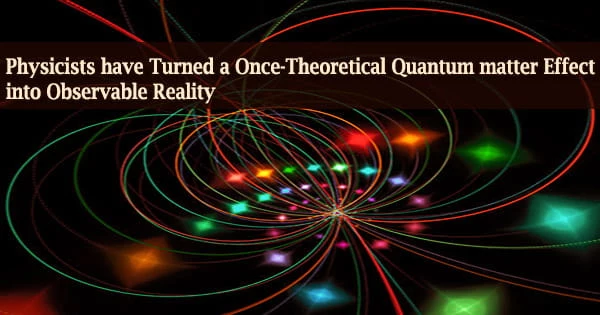Physicists from the University of California, Santa Barbara, have become the first to witness a peculiar quantum behavior: the “quantum boomerang” effect, which occurs when particles in a disordered system are thrown out of their positions. Instead of landing somewhere else, as one might assume, they circle back to where they started and come to a halt.
“It’s really a fundamentally quantum mechanical effect,” said atomic physicist David Weld, whose lab produced the effect and documented it in a paper published in Physical Review X. “There’s no classical explanation for this phenomenon.”
The boomerang effect is based on a disorder-induced behavior known as Anderson localization, which restricts electron transit and was predicted by physicist Philip Anderson some 60 years ago.
According to the paper’s primary author Roshan Sajjad, the disorder might be caused by impurities, flaws, misalignments, or other disruptions in the atomic lattice of a material.
“This type of disorder will keep them from basically dispersing anywhere,” Sajjad said.
As a result, rather than flying around the lattice, the electrons localize, changing what would otherwise be a conducting material into an insulator. The quantum boomerang effect was anticipated a few years ago to emerge from this rather sticky quantum situation.
It’s exceedingly difficult, if not impossible, to launch disordered electrons out from their localized point and follow them to watch their behavior, but the Weld Lab had a few tricks up its sleeve.
It’s just a really very fundamentally different behavior. Take a quantum version of the same thing, and what you see is that it starts gaining energy at short times, but at some point it just stops and it never absorbs any more energy. It becomes what’s called a dynamically localized state.
David Weld
The researchers were able to create the lattice and disorder, as well as observe the launch and return of the boomerang, using a gas of 100,000 ultra-cold lithium atoms suspended in a standing wave of light and “kicking” them, emulating a so-called quantum kicked rotor (“similar to a periodically kicked pendulum,” both Weld and Sajjad said). They worked in momentum space, a strategy that avoids some experimental challenges while maintaining the boomerang effect’s underlying physics.
“In normal, position space, if you’re looking for the boomerang effect, you’d give your electron some finite velocity and then look for whether it came back to the same spot,” Sajjad explained.
“Because we’re in momentum space, we start with a system that is at zero average momentum, and we look for some departure followed by a return to zero average momentum.”
They pulsed the lattice a few dozen times with their quantum kicked rotor, noticing an early shift in average momentum. Despite repeated kicks, average momentum eventually dropped to zero.
“It’s just a really very fundamentally different behavior,” Weld said. In a classical system, he explained, a rotor kicked in this way would respond by constantly absorbing energy from the kicks.
“Take a quantum version of the same thing, and what you see is that it starts gaining energy at short times, but at some point it just stops and it never absorbs any more energy. It becomes what’s called a dynamically localized state.”
This behavior, he said, is due to the wave-like nature of quantum systems.
“That chunk of stuff that you’re pushing away is not only a particle, but it’s also a wave, and that’s a central concept of quantum mechanics,” Weld explained. “Because of that wave-like nature, it’s subject to interference, and that interference in this system turns out to stabilize a return and dwelling at the origin.”
The researchers demonstrated that the boomerang effect is produced by periodic kicks with time-reversal symmetry, but that randomly timed kicks disrupt both the symmetry and, as a result, the boomerang effect.
The Weld Lab’s next project: If individual boomerang effects are fun, imagine how much more fun it would be to have multiple interacting boomerang effects.
“There are a lot of theories and questions about what should happen would interactions destroy the boomerang? Are there interesting many-body effects?” Sajjad said. “The other exciting thing is that we can actually use the system to study the boomerang in higher dimensions.”
Jeremy L. Tanlimco, Hector Mas, Eber Nolasco-Martinez, and Ethan Q. Simmons of UCSB, Tommaso Macr of Universidade Federal do Rio Grande do Norte, and Patrizia Vignolo of Université Côte d’Azur also worked on this research.
















